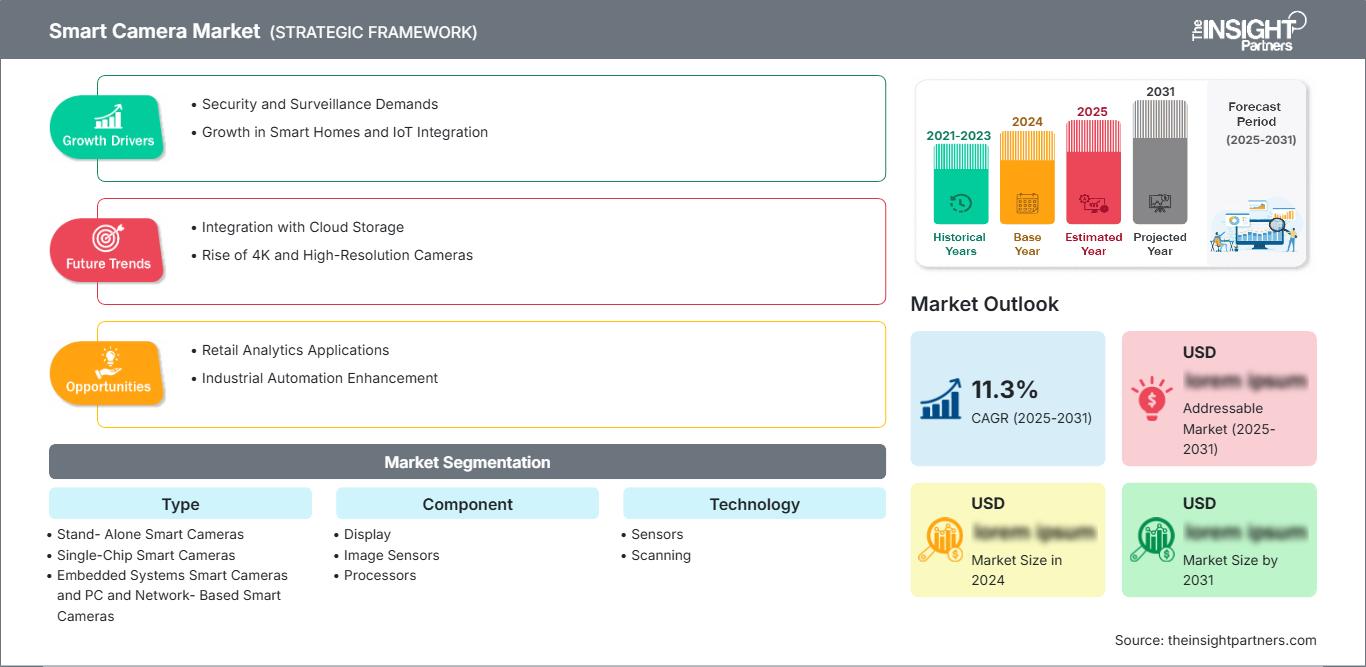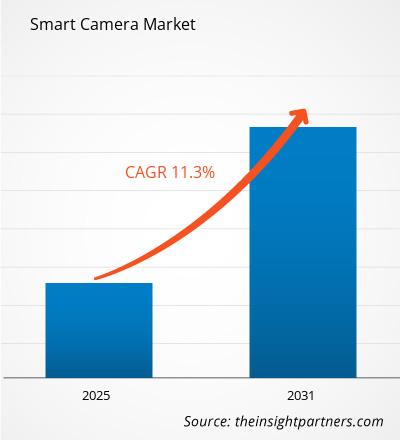预计智能相机市场在 2025 年至 2031 年期间的复合年增长率为 11.3%,市场规模将从 2024 年的 XX 百万美元扩大到 2031 年的 XX 百万美元。
报告按类型(独立智能相机、单芯片智能相机、嵌入式系统智能相机以及基于 PC 和网络的智能相机)、组件(显示器、图像传感器、处理器、镜头等)、技术(传感器、扫描)、应用(视频监控、消费电子、工业、交通运输、汽车、医疗等)、连接性(Wi-Fi、蓝牙、无线 HART 等)细分。全球分析进一步细分为区域和主要国家。报告以美元为单位,列出了上述分析和细分市场的价值。
报告目的
Insight Partners 发布的《智能相机市场》报告旨在描述当前市场格局和未来增长、主要驱动因素、挑战和机遇。这将为各业务利益相关者提供洞见,例如:
- 技术提供商/制造商:了解不断变化的市场动态并掌握潜在的增长机会,从而做出明智的战略决策。
- 投资者:对市场增长率、市场财务预测以及整个价值链中存在的机遇进行全面的趋势分析。
- 监管机构:规范市场政策和警务活动,以最大程度地减少滥用行为,维护投资者的信任和信心,并维护市场的完整性和稳定性。
智能相机市场细分类型
- 独立智能相机
- 单芯片智能相机
- 嵌入式系统智能相机以及基于 PC 和网络的智能相机
组件
- 显示器
- 图像传感器
- 处理器
- 镜头及其他
技术
- 传感器
- 扫描
应用
- 视频监控
- 消费电子
- 工业
- 交通运输
- 汽车
- 医疗及其他
连接性
- Wi-Fi
- 蓝牙
- 无线 HART 及其他
您将免费获得任何报告的定制,包括本报告的部分内容,或国家级分析、Excel 数据包,以及为初创企业和大学提供超值优惠和折扣
智能相机市场: 战略洞察

- 获取本报告的主要市场趋势。这个免费样本将包括数据分析,从市场趋势到估计和预测。
智能摄像头市场增长动力
- 安防和监控需求:住宅、商业和政府部门日益增长的安全担忧推动了智能摄像头的使用。面部识别、运动检测和行为分析等人工智能功能的结合,可以实现高级威胁识别和自动监控,使得这些摄像头对于当前的安防系统至关重要。
- 智能家居和物联网集成的增长:智能家居的快速发展和物联网 (IoT) 的集成正在推动对智能摄像头的需求。这些摄像头可以无缝集成到智能家居生态系统中,使用户可以通过智能手机或其他设备远程监控他们的家。这一趋势正在推动智能摄像头在各种消费应用中的普及。
智能摄像头市场未来趋势
- 与云存储集成:智能摄像头越来越多地与云存储解决方案集成,使用户可以远程存储和访问录像。云集成可实现无缝数据备份和检索,无需本地存储设备。这一趋势在持续记录和数据安全至关重要的应用中尤其有利,例如监控和监测。
- 4K 和高分辨率摄像机的兴起:市场对提供卓越图像质量的 4K 和高分辨率智能摄像机的需求日益增长。随着安防、制造和零售分析对详细视频录像的依赖日益加深,高清智能摄像机正在成为行业标准。随着消费者和企业对图像清晰度和精度的期望不断提高,这一趋势正在加速发展。
智能摄像机市场机遇
- 零售分析应用:智能摄像机在零售业中拥有巨大的前景,可用于分析顾客行为、优化门店和管理库存。热图、停留时间分析和人口统计分析等先进功能,可帮助企业评估购买趋势、优化门店布局、提升客户体验,同时提升运营效率。
- 工业自动化增强:智能摄像头越来越多地应用于制造工厂,用于规范质量、监控流程和确保工作场所安全。机器学习算法的结合,可实现自动故障检测、预测性维护和合规性监控,为工业自动化领域带来巨大的发展前景。
智能相机市场区域洞察
The Insight Partners 的分析师已详尽阐述了预测期内影响智能相机市场的区域趋势和因素。本节还讨论了北美、欧洲、亚太地区、中东和非洲以及南美和中美洲的智能相机市场细分和地域分布。
智能相机市场报告范围
| 报告属性 | 细节 |
|---|---|
| 市场规模 2024 | US$ XX million |
| 市场规模 2031 | US$ XX Million |
| 全球复合年增长率 (2025 - 2031) | 11.3% |
| 历史数据 | 2021-2023 |
| 预测期 | 2025-2031 |
| 涵盖的领域 |
By 类型
|
| 覆盖地区和国家 | 北美
|
| 市场领导者和主要公司简介 |
|
智能相机市场参与者密度:了解其对业务动态的影响
智能相机市场正在快速增长,这得益于终端用户需求的不断增长,而这些需求的驱动因素包括消费者偏好的不断变化、技术进步以及对产品优势的认知度不断提高。随着需求的增长,企业正在扩展其产品线,不断创新以满足消费者需求,并抓住新兴趋势,从而进一步推动市场增长。

- 获取 智能相机市场 主要参与者概述
主要卖点
- 全面覆盖:该报告全面涵盖了对智能相机市场的产品、服务、类型和最终用户的分析,提供了整体格局。
- 专家分析:该报告基于对行业专家和分析师的深入了解而编写。
- 最新信息:由于涵盖了最新信息和数据趋势,该报告确保了业务相关性。
- 定制选项:此报告可以根据特定客户要求进行定制,并恰如其分地适应业务策略。
因此,智能相机市场研究报告可以帮助引领解读和理解行业情景和增长前景的线索。尽管可能存在一些合理的担忧,但本报告的总体优势往往大于劣势。
- 历史分析(2 年)、基准年、预测(7 年)及复合年增长率
- PEST和SWOT分析
- 市场规模、价值/数量 - 全球、区域、国家
- 行业和竞争格局
- Excel 数据集
近期报告
相关报告
客户评价
购买理由
- 明智的决策
- 了解市场动态
- 竞争分析
- 客户洞察
- 市场预测
- 风险规避
- 战略规划
- 投资论证
- 识别新兴市场
- 优化营销策略
- 提升运营效率
- 顺应监管趋势




















 获取免费样品 - 智能相机市场
获取免费样品 - 智能相机市场